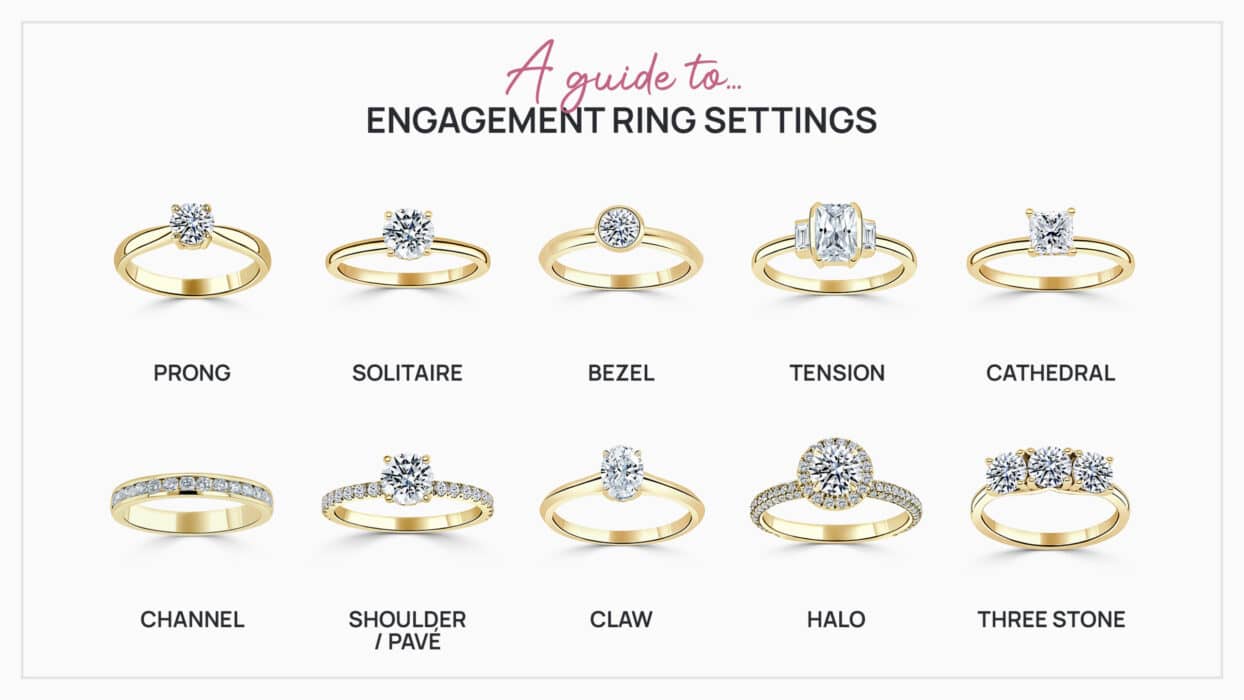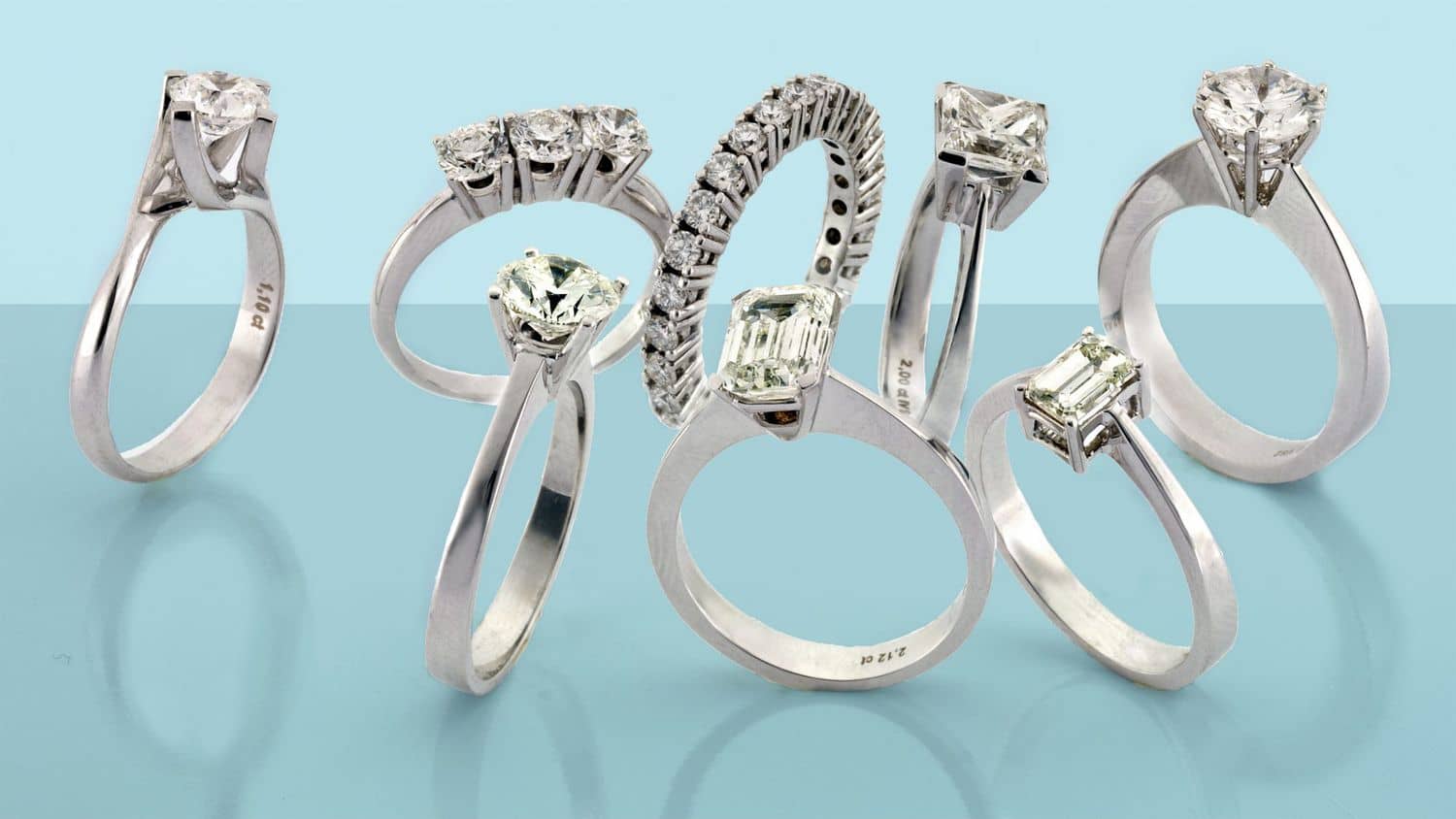Are you looking to learn more about the different types of ring settings? This guide can help you make an informed decision when it comes to selecting the perfect ring setting for your engagement, wedding, or anniversary ring. We’ll cover the types of settings available, the characteristics of each, and the advantages of each. Ready to get started?

1. Prong Settings
Prong settings are a popular choice for engagement rings and other types of jewellery. They are also known as claw settings because of the small prongs that hold the gemstone in place. Prongs are raised pieces of metal that grip the stone and keep it secure. They are usually made of platinum, gold or white gold.
Prong settings can have four, six, or eight prongs. The more prongs, the more secure the stone will be. However, more prongs can also make the stone look smaller and hide some of its sparkle. Four prongs are the most common choice because they allow more light to enter the gemstone and increase its brilliance.
Prong settings work well with diamonds and other transparent gems because they allow light to pass through the stone and reflect off its facets. They also make the stone appear larger than it actually is. However, prong settings are not suitable for softer stones like opals and pearls because the prongs can scratch or damage them.
Overall, prong settings are a classic choice for engagement rings and other types of jewellery. They are versatile, elegant, and timeless.

2. Bezel Settings
Bezel settings are a popular choice for engagement rings and other types of jewellery. This setting type is when the gemstone is held in place with a metal rim that surrounds the stone, rather than prongs or claws.
One advantage of a bezel setting is that it is very secure, as the metal surrounds the stone and holds it firmly in place. This is a great option for those who lead an active lifestyle or work with their hands. Additionally, the bezel setting can protect the edges of the stone from chips and scratches.
Another benefit of a bezel setting is that it can make the stone appear larger and more prominent. The metal rim can create a frame around the stone, drawing the eye to it and making it stand out.
Some people may prefer the look of a prong setting, as it allows more light to enter the stone and can create a more delicate, elegant look. However, a bezel setting can be a great option for those who want a more modern, bold look for their ring.
Overall, a bezel setting can be a great choice for those who value security, durability, and a bold look for their ring.

3. Halo Settings
A halo setting is an elegant and timeless style of jewelry setting that has been popular for centuries. It is a type of setting that has a central diamond or gemstone surrounded by a halo of smaller stones. The halo of stones can be either diamonds or gemstones and they can be set in various shapes, such as round, oval, square, and more.
The halo setting adds a lot of extra sparkle to a piece of jewelry, making it look larger and more impressive. It is also a great way to add extra color to a piece of jewelry, as smaller gemstones can be used to add a splash of color.
When it comes to choosing a halo setting, there are many options available. The size of the halo, the shape of the halo, and the type of stones used to create the halo can all be customized to create a unique look.
In addition to the look of the halo setting, there are also a few practical considerations. For example, the smaller stones in the halo can be more prone to chipping and damage than a larger stone, so it is important to choose a quality setting that is designed to protect the smaller stones.
Halo settings are a great way to add extra sparkle and color to a piece of jewelry and make it look larger and more impressive. With so many options available, it is easy to create a unique and beautiful piece of jewelry with a halo setting.

4. Channel Settings
A channel setting is a popular choice for rings, as it gives the stones a secure yet elegant setting. This type of setting is created by two strips of metal, which are then soldered together to form a channel. The stones are then placed within the channel and secured. This setting is often used for eternity rings, as it allows for a continuous line of stones.
When choosing a channel setting, it is important to consider the type of metal used to create the channel. This will affect the look and durability of the setting, and should be discussed with a jeweller. The stones used in the channel should also be chosen carefully, as they will be visible from all angles.
The channel setting is a great choice for those who want a secure yet eye-catching setting for their ring. It can be used with a variety of stones, and the metal used in the channel can be chosen to match the wearer’s individual style.

5. Bar Settings
Bar settings are a very popular type of ring setting that has a contemporary look. This type of setting typically features a metal bar that runs along the length of the ring, and the diamond or gemstone is then set into the middle of the bar. Bar settings are a great option for a modern look, and they also provide a secure setting for the stone.
The bar setting is also a very versatile setting, as it can be used with almost any type of diamond or gemstone. It can also be used with either a single stone or multiple stones. The bar setting is also very affordable, so it’s a great option for anyone on a budget.
When choosing a bar setting, it’s important to consider the size of the stone and the size of the band. This will ensure that the stone is secure and the band is comfortable. It’s also important to consider the metal that the bar is made from, as this will affect the durability and look of the ring.
When it comes to caring for a bar setting, it’s important to regularly clean the metal and the stone. This will help to ensure that the ring is looking its best. It’s also important to take the ring off before any activities that could cause damage, such as swimming or showering.
For an even more modern look, consider adding a contrasting metal bar to the ring. This will create an eye-catching contrast and will give the ring an even more unique look.

6. Tension Settings
A tension setting is a modern, contemporary design for rings that creates the illusion of the diamond or gemstone appearing to be held in place without any metal. This unique design is created by having the metal of the ring wrap around and hold the diamond in place, creating an eye-catching and secure setting. The tension setting is a popular choice for engagement rings, as it is a modern and stylish design.
A tension setting is typically made using a band of metal that is slightly thicker than a traditional ring band, and the diamond or gemstone will be placed in the centre of the ring. To create the illusion of the diamond or gemstone being suspended, the metal will wrap around the stone in a way that creates tension and holds the stone in place. The metal of the ring is usually flat against the diamond or gemstone, creating a smooth and seamless look.
The tension setting is a great choice for those who want a modern, stylish look for their ring. This setting is often chosen for engagement rings, as it is an eye-catching, unique design that is sure to draw attention. However, this setting is also a great choice for those who want a contemporary look for any type of ring.

When choosing a tension setting for your ring, it is important to ensure that the metal is strong enough to securely hold the diamond or gemstone in place. It is also important to ensure that the metal is thick enough to support the stone and ensure that the tension setting will remain secure. For added security, it is recommended to have the ring professionally checked for wear andIn conclusion, we hope that you have learned a lot from this guide to different types of ring settings. We have covered the most popular types of settings, their characteristics, and their advantages. By reading this guide, you should now be able to make an informed decision when it comes to selecting the perfect ring setting for your engagement, wedding, or anniversary ring.
Conclusion:
Ring settings play a crucial role in enhancing the beauty of gemstones and defining the overall look of a ring. From the classic prong setting, which offers security and maximum light exposure to the stone, to the bezel setting that encircles the gemstone for a modern look, each setting has its unique characteristics. The halo setting, with its circle of smaller stones around the central gem, offers a vintage appeal, while the tension setting creates an illusion of the stone floating. The choice of setting can influence the ring’s style, the protection it offers to the stone, and its maintenance needs.
